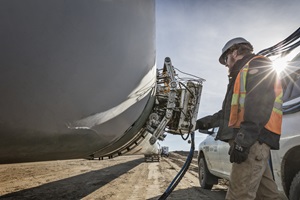Comprehensive Introduction of Pipeline Welding Assessment Treatments
Pipeline welding inspection treatments play a critical role in assuring that bonded links fulfill rigorous industry criteria and specifications. From careful pre-welding examinations to comprehensive post-weld assessments, a distinct evaluation process is necessary for maintaining the structural sturdiness of pipes.
Pre-welding Inspection Preparations
Prior to beginning the welding process, comprehensive pre-welding inspection preparations are vital to make sure the honesty and top quality of the weld joint. These prep work include a meticulous evaluation of the products to be welded, the welding devices, and the workplace. The materials must be evaluated for any issues, pollutants, or variances that can endanger the weld. This includes monitoring for proper material qualities, dimensions, and surface problems. Pipeline Welding Inspection. Additionally, the welding devices needs to be examined to validate that it is in great working problem, calibrated properly, and appropriate for the details welding process. Any type of problems with the devices must be dealt with promptly to avoid issues in the weld. The work environment have to be assessed for cleanliness, appropriate ventilation, and safety steps to make sure a helpful setting for the welding operation. By conducting extensive pre-welding assessment preparations, possible problems can be determined and fixed early on, bring about top quality and reputable weld joints.
Welding Procedure Qualification
Detailed pre-welding evaluation prep work lay the foundation for the vital process of Welding Treatment Certification, making certain the stability and high quality of the weld joint. Welding Treatment Certification (WPQ) is an important step in the welding process that includes testing and certifying welding procedures to guarantee they meet details criteria and needs. The WPQ procedure generally consists of welding procedure requirements development, welding procedure qualification screening, and documentation of the results.
Throughout welding procedure specification development, crucial details such as the welding process, welding materials, joint layout, and welding criteria are specified to develop an extensive treatment. Subsequently, welding procedure qualification screening is conducted to verify the proposed treatment's stability. This screening typically includes welding examination promo codes that are subjected to numerous mechanical and non-destructive tests to evaluate the weld's top quality and adherence to the specified criteria.
In-process Weld Assessment
Throughout the welding procedure, in-process weld assessment plays a vital function in making sure the top quality and honesty of the weld joint - Pipeline Welding Inspection. This kind of examination entails keeping an eye on the welding criteria, assessing the weld bead formation, and identifying any kind of potential flaws or discontinuities as they take place. By moved here carrying out in-process weld examinations, welding drivers can immediately resolve any kind of issues that may arise, thus making certain and preventing additional flaws that the final weld satisfies the called for specs
Usual approaches made use of for in-process weld inspection consist of visual inspection, liquid penetrant testing, magnetic particle screening, ultrasonic screening, and radiographic screening. On the whole, in-process weld examination is essential for maintaining the quality and dependability of bonded pipelines.
Non-destructive Testing (NDT)
Non-destructive Testing (NDT) is a vital technique employed in pipeline welding inspection to assess the honesty of weld joints without creating damages to the bonded framework. By using various NDT techniques, inspectors can review the top quality of welds and determine any kind of flaws or suspensions that might compromise the architectural stability of the pipeline. Usual NDT methods utilized in pipe welding inspection include Radiographic Testing (RT), Ultrasonic Testing (UT), Magnetic Fragment Testing (MPT), Fluid Penetrant Screening (LPT), and Visual Testing (VT)
RT involves using X-rays or gamma rays to create photos of the internal structure of the weld, allowing inspectors to detect here are the findings problems such as porosity, fractures, or incomplete blend. UT makes use of high-frequency sound waves to discover defects underneath the surface area of the weld, providing thorough info concerning the dimension and area of flaws. MPT and LPT are used to identify surface-breaking flaws by using magnetic bits or penetrant fluids to the weld area. Additionally, VT includes visual evaluation of welds to identify any type of visible blemishes.
Post-weld Assessment and Documents

Documents of post-weld evaluation searchings for is essential for keeping top quality control documents and ensuring compliance with sector criteria and guidelines. Thorough records ought to include details about the evaluation methods utilized, the place and nature of any type of defects found, and any kind of rehabilitative actions taken - Pipeline Welding Inspection. Proper documents not just offers as a record of the weld's top quality but additionally help in future upkeep and evaluation processes
Final Thought

In conclusion, pipeline welding examination treatments play a critical duty in ensuring the quality and integrity of welds. Overall, adherence to correct assessment protocols is key to the success of pipeline welding tasks.
From meticulous pre-welding examinations to thorough post-weld evaluations, a well-defined inspection process is crucial for keeping the architectural soundness of pipes. By carrying out in-process weld examinations, welding operators can without delay deal with any problems that may arise, consequently avoiding additional issues and making sure that the final weld fulfills the needed specifications.
Typical techniques made use of for in-process weld assessment consist of aesthetic examination, Read More Here liquid penetrant testing, magnetic particle testing, ultrasonic testing, and radiographic testing.Non-destructive Screening (NDT) is a crucial technique employed in pipe welding examination to examine the stability of weld joints without creating damages to the bonded framework. Post-weld examination entails various approaches to assess the welds for issues, consisting of visual evaluation, dye penetrant testing, magnetic fragment testing, ultrasonic screening, and radiographic testing.